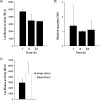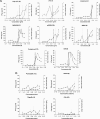Investigating Toll-like receptor agonists for potential to treat hepatitis C virus infection
- PMID: 17548497
- PMCID: PMC1932540
- DOI: 10.1128/AAC.00268-07
Investigating Toll-like receptor agonists for potential to treat hepatitis C virus infection
Abstract
Toll-like receptors (TLRs) are key mediators of innate immunity, and their activation by microbial components leads to the production of cytokines and interferons. Recombinant alpha interferon has been used to treat several viral diseases and is the current standard of care for hepatitis C virus (HCV) infection. Recently, agonists of TLR7 and TLR9 have been shown to have clinical efficacy in HCV patients, and this is correlated with their ability to induce endogenous type I interferon production. We have carried out a comprehensive study of agonists of TLRs 1 to 9 to determine if any additional TLRs can induce antiviral molecules from human peripheral blood mononuclear cells (PBMCs). The agonists were incubated with PBMCs, and the supernatant was then removed and added to HCV replicon cells to assess antiviral activity. Agonists of TLRs 3, 4, 7, 8, and 9 were found to be potent inducers of antiviral activity in PBMC supernatants, and the activity correlated with the induction of alpha interferon and the interferon-induced antiviral biomarker 2',5'-oligoadenylate synthase. Antiviral activity of TLR7 and TLR8 agonists was blocked by an antibody that binds to the type I interferon receptor, confirming that the antiviral activity results from type I interferon induction. TLR4 and TLR8 agonists were found to strongly induce the proinflammatory cytokines interleukin 1beta and tumor necrosis factor alpha at concentrations similar to those inducing antiviral activity. This raises concerns about adverse side effects if these were to be used as antiviral agents. We therefore conclude that TLRs 3, 7, and 9 represent the most attractive targets for the development of new HCV therapies.
Figures








Similar articles
-
The dysfunctional innate immune response triggered by Toll-like receptor activation is restored by TLR7/TLR8 and TLR9 ligands in cutaneous lichen planus.Br J Dermatol. 2015 Jan;172(1):48-55. doi: 10.1111/bjd.13214. Epub 2014 Nov 20. Br J Dermatol. 2015. PMID: 24976336
-
Toll-Like Receptor 7 (TLR-7) and TLR-9 Agonists Improve Hepatitis C Virus Replication and Infectivity Inhibition by Plasmacytoid Dendritic Cells.J Virol. 2018 Nov 12;92(23):e01219-18. doi: 10.1128/JVI.01219-18. Print 2018 Dec 1. J Virol. 2018. PMID: 30232187 Free PMC article.
-
Toll-like receptor activated human and murine hepatic stellate cells are potent regulators of hepatitis C virus replication.J Hepatol. 2009 Dec;51(6):1037-45. doi: 10.1016/j.jhep.2009.06.020. Epub 2009 Jul 29. J Hepatol. 2009. PMID: 19716616
-
Toll-like receptors and hepatitis C virus infection.Hepatobiliary Pancreat Dis Int. 2021 Dec;20(6):521-529. doi: 10.1016/j.hbpd.2021.07.011. Epub 2021 Aug 10. Hepatobiliary Pancreat Dis Int. 2021. PMID: 34419367 Review.
-
The pharmacology of endosomal TLR agonists in viral disease.Biochem Soc Trans. 2007 Dec;35(Pt 6):1468-72. doi: 10.1042/BST0351468. Biochem Soc Trans. 2007. PMID: 18031247 Review.
Cited by
-
Regulatory phenotype, PD-1 and TLR3 expression in T cells and monocytes from HCV patients undergoing antiviral therapy: a randomized clinical trial.PLoS One. 2014 Apr 7;9(4):e93620. doi: 10.1371/journal.pone.0093620. eCollection 2014. PLoS One. 2014. PMID: 24709775 Free PMC article. Clinical Trial.
-
TLR3, TLR4 and TLRs7-9 Induced Interferons Are Not Impaired in Airway and Blood Cells in Well Controlled Asthma.PLoS One. 2013 Jun 18;8(6):e65921. doi: 10.1371/journal.pone.0065921. Print 2013. PLoS One. 2013. PMID: 23824215 Free PMC article.
-
Toll-like receptors in liver fibrosis: cellular crosstalk and mechanisms.Front Physiol. 2012 May 22;3:138. doi: 10.3389/fphys.2012.00138. eCollection 2012. Front Physiol. 2012. PMID: 22661952 Free PMC article.
-
Toll-like Receptor Response to Hepatitis C Virus Infection: A Recent Overview.Int J Mol Sci. 2022 May 13;23(10):5475. doi: 10.3390/ijms23105475. Int J Mol Sci. 2022. PMID: 35628287 Free PMC article. Review.
-
Innate Immunity and Immune Evasion by Enterovirus 71.Viruses. 2015 Dec 14;7(12):6613-30. doi: 10.3390/v7122961. Viruses. 2015. PMID: 26694447 Free PMC article. Review.
References
-
- Akira, S., and K. Takeda. 2004. Toll-like receptor signalling. Nat. Rev. Immunol. 4:499-511. - PubMed
-
- Antonelli, G., G. Giannelli, M. Currenti, E. Simeoni, S. Del Vecchio, F. Maggi, M. Pistello, L. Roffi, G. Pastore, L. Chemello, and F. Dianzani. 1996. Antibodies to interferon (IFN) in hepatitis C patients relapsing while continuing recombinant IFN-alpha2 therapy. Clin. Exp. Immunol. 104:384-387. - PMC - PubMed
MeSH terms
Substances
LinkOut - more resources
Full Text Sources
Other Literature Sources
Miscellaneous

